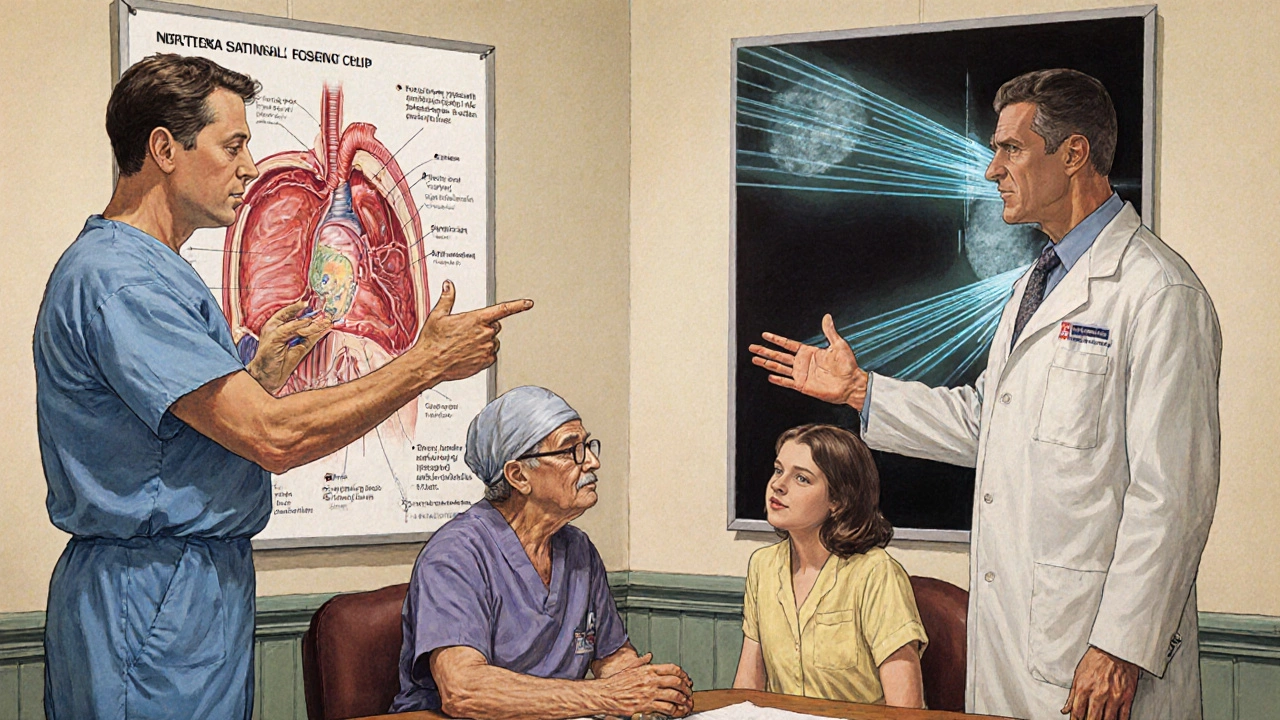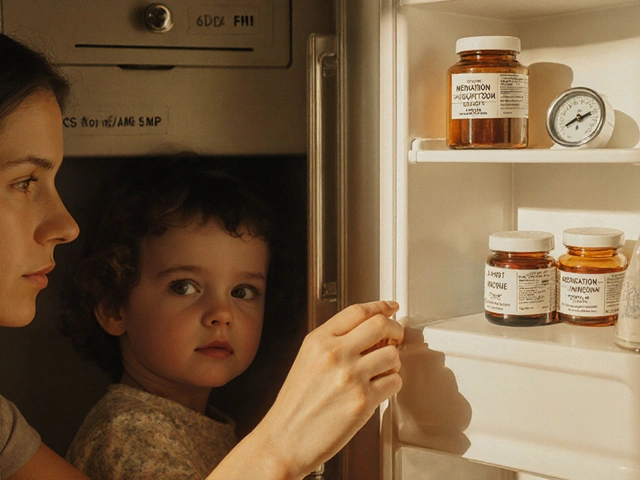When cancer is caught early, you’re faced with a choice: remove it or zap it.
For many people diagnosed with localized cancer-whether it’s in the prostate, lung, or another organ-the decision between radiation and surgery isn’t just medical. It’s personal. You’re not just picking a treatment. You’re picking a lifestyle change, a recovery path, and a set of trade-offs that will shape your next five, ten, or even twenty years.
There’s no one-size-fits-all answer. What works best for one person might leave another struggling with side effects that feel worse than the cancer itself. And yet, most patients don’t get the full picture before deciding. They hear ‘surgery removes it all’ or ‘radiation is less invasive’ and assume that’s the whole story. It’s not.
Let’s cut through the noise. Here’s what actually happens with each option, how they compare in real life, and how to figure out which one fits you.
Surgery: The Physical Removal
Surgery means cutting out the tumor-and sometimes, part of the organ it’s in. For prostate cancer, that’s a radical prostatectomy. For lung cancer, it could mean removing a lobe or even an entire lung. The goal is simple: get rid of the cancer in one go.
Modern techniques have made this less brutal than it sounds. Robotic-assisted surgery, laparoscopic tools, and video-guided systems mean smaller cuts, less blood loss, and faster healing. But it’s still major surgery. You’ll spend a few days in the hospital. Recovery takes weeks. You won’t be lifting anything heavy for a month. Some people need help with daily tasks for weeks after.
The big advantage? You get a clear picture of what was removed. Pathologists examine the tissue under a microscope and tell you exactly how far the cancer spread. That’s something radiation can’t do. If the margins are clean-no cancer cells at the edges-you know you got it all. That certainty matters.
But here’s the catch: side effects are often immediate and lasting. For men with prostate cancer, urinary leakage after surgery is common. Studies show 14% still have leakage 10 years later. Erectile dysfunction hits about 50-60% of patients in the first year. These aren’t temporary inconveniences. They’re life-altering changes.
For lung cancer, surgery carries risks like pneumonia, collapsed lung, or long-term breathing issues. Recovery is slower than radiation, but for those who can handle it, the survival numbers are strong. One large study of over 30,000 patients found that five-year survival after lung cancer surgery was 71.4%. That’s significantly higher than radiation for patients who are healthy enough for surgery.
Radiation: The Invisible Scalpel
Radiation doesn’t cut. It burns. High-energy beams target cancer cells with pinpoint accuracy, damaging their DNA so they can’t multiply. Modern machines can hit tumors within 1-2 millimeters of precision. That’s like hitting a coin from 100 yards away-repeatedly.
There are two main types: traditional radiation and stereotactic body radiation therapy (SBRT). Traditional radiation for prostate cancer means daily treatments-five days a week-for 7 to 9 weeks. Each session takes 15 to 30 minutes. You drive in, lie down, get zapped, and go home. No hospital stay. No recovery time between sessions.
SBRT is different. It’s high-dose, ultra-focused radiation delivered in just 1 to 5 sessions. It’s becoming the go-to for early-stage lung cancer patients who can’t have surgery. No cutting. No hospital. You might feel tired for a few days, but most people keep working.
The big perk? Organ preservation. Your prostate stays in place. Your lung keeps most of its tissue. That means fewer immediate physical changes. But radiation’s side effects sneak up over time.
For prostate cancer, bowel problems are the main concern. About 7% of radiation patients report serious bowel issues 10 years later-think frequent diarrhea, urgency, or rectal bleeding. That’s higher than surgery. Urinary problems are less common with radiation than surgery, but they still happen. And erectile dysfunction? It comes on slower than with surgery, but by the 5-year mark, the rates are similar.
For lung cancer patients, radiation can cause inflammation in the lung tissue, leading to coughing or shortness of breath. In rare cases, it can damage the esophagus or heart. But for patients who aren’t surgical candidates-older adults, those with heart or lung disease-radiation offers a real shot at survival. Studies show 40-50% of inoperable stage I lung cancer patients live five years after SBRT.

Survival Rates: Is One Better?
This is where things get messy. People want a clear winner: ‘Which saves more lives?’ The answer? It depends.
For low-risk prostate cancer, two major studies tell different stories. The ProtecT trial, which followed 1,643 men for 10 years, found no difference in survival between surgery, radiation, or even active monitoring. Survival rates were all above 95%. But a separate study of 91,000 men by UCSF found surgery had better long-term survival-especially for high-risk cases. At 15 years, surgery patients lived 62% of the time. Radiation patients? 52%.
Why the gap? The ProtecT trial mostly included low-risk patients. The UCSF study had more high-risk cases. Risk level matters. If your cancer is aggressive, surgery may give you a better chance. If it’s slow-growing, radiation might be just as good-with fewer immediate side effects.
For lung cancer, the numbers are clearer. Surgery wins. In a study of 30,658 patients, those who had surgery lived longer: 71.4% survived five years versus 55.9% for SBRT. But-and this is critical-SBRT was given to patients who weren’t healthy enough for surgery. When you compare only patients who could have had surgery, the gap narrows. Still, for those who can handle it, surgery remains the gold standard.
Bottom line: Survival isn’t about which treatment is ‘better.’ It’s about which one is right for your cancer’s behavior and your body’s ability to handle it.
Side Effects: What You’ll Live With
Survival is important. But quality of life? That’s what you wake up to every morning.
Let’s break it down by organ.
Prostate cancer:
- Surgery: Urinary leakage (14% at 10 years), erectile dysfunction (50-60% at 1 year), dry orgasm (almost universal).
- Radiation: Bowel problems (7% at 10 years), urinary irritation (temporary for most), erectile dysfunction (catches up to surgery by year 5).
If you’re young, active, and want to keep your sexual function as long as possible, radiation might feel safer. But if you hate the idea of wearing pads or worrying about bowel accidents, surgery might be worth the trade-off.
Lung cancer:
- Surgery: Shortness of breath, reduced lung capacity, pain during recovery, risk of infection.
- Radiation: Fatigue, coughing, radiation pneumonitis (lung inflammation), potential heart damage if tumor is near the center.
For someone with COPD or heart disease, radiation avoids the trauma of opening the chest. For a healthy 55-year-old, surgery gives the best shot at long-term freedom from cancer.
Logistics: Time, Travel, and Life Interruptions
Most people don’t think about this until they’re halfway through treatment.
Radiation for prostate cancer means 35-45 visits over two months. If you live 45 minutes from the clinic, that’s 1.5 hours a day, five days a week. That’s a lot of time off work. A lot of gas money. A lot of stress for caregivers.
Surgery? One day in the hospital. Two weeks of recovery. Then you’re mostly back to normal. No daily trips. No long-term schedule to manage.
SBRT for lung cancer is even simpler: 1 to 5 visits over two weeks. That’s why it’s so popular for older patients or those with busy lives. No hospital stay. No long recovery. Just a few quick treatments.
If you’re a single parent, work long hours, or don’t have reliable transportation, radiation’s daily grind might be impossible. Surgery’s concentrated recovery might be the better fit.

Who Gets What? The Real Guidelines
Doctors don’t guess. They follow evidence-based rules.
For prostate cancer:
- Very low risk: Active monitoring (watch and wait).
- Low to high risk: Surgery or radiation are both standard options.
- High risk or aggressive: Surgery often preferred, sometimes combined with hormone therapy.
For early-stage lung cancer:
- Medically operable: Surgery is the recommended first choice.
- Medically inoperable: SBRT is the top alternative.
These aren’t hard rules. They’re starting points. The National Comprehensive Cancer Network (NCCN) and the American Society of Clinical Oncology both say: talk to both a surgeon and a radiation oncologist before deciding.
Too many patients only meet one specialist. They hear ‘my way is best’ and make a choice based on one opinion. That’s not enough. You need two perspectives.
What You Should Do Next
If you’re facing this decision, here’s your action plan:
- Get your cancer staged properly. Know your risk group-low, intermediate, or high.
- Request consultations with both a urologist (for prostate) or thoracic surgeon (for lung) AND a radiation oncologist.
- Ask both doctors: ‘If this were your parent, what would you recommend?’
- Use tools like the Prostate Cancer Foundation’s decision tool. It’s based on data from over 129,000 patients.
- Write down your priorities: Is preserving sexual function more important than avoiding bowel issues? Do you need to get back to work fast? Are you willing to travel daily for weeks?
- Don’t rush. This isn’t an emergency. Most localized cancers grow slowly. You have weeks, not days, to decide.
There’s no perfect choice. Only the right one-for your body, your life, and your values.
What’s Coming Next
The field is changing fast. Focal therapy for prostate cancer-where only the tumor is treated, not the whole gland-is in trials. Proton beam radiation, which may reduce side effects, is becoming more available. And AI is helping predict who’s most likely to benefit from each option.
One study called PARTICLE, which compares partial gland ablation to full treatment, will have results in 2025. That could shift the balance again.
For now, though, the best advice hasn’t changed: Know your options. Get both opinions. Choose based on your life-not just your cancer.
Is radiation safer than surgery for prostate cancer?
Neither is universally safer. Surgery has higher risks of immediate urinary and sexual side effects, while radiation carries a higher risk of long-term bowel problems. For low-risk prostate cancer, both have nearly identical survival rates. The ‘safer’ option depends on what side effects you’re willing to live with.
Can I have surgery after radiation if the cancer comes back?
It’s possible, but much harder and riskier. Radiation changes tissue, making surgery more likely to cause serious complications like urinary fistulas or incontinence. That’s why many doctors recommend surgery first if you’re a good candidate-it leaves radiation as a backup option if needed.
Does radiation cause cancer elsewhere in the body?
The risk is extremely low. Modern radiation is tightly focused. Studies show a tiny increase in secondary cancers-less than 1% over 10 years-but this risk is far smaller than the chance of the original cancer returning if untreated. The benefit of controlling your current cancer far outweighs this minimal risk.
Why do some doctors push one treatment over the other?
Doctors often recommend what they know best. Surgeons see the value in removing tissue. Radiation oncologists see the benefits of non-invasive treatment. That’s why guidelines say you must consult both. Your decision should be based on your cancer and your life-not on who you talked to first.
Is SBRT as good as surgery for lung cancer?
For patients who can’t have surgery, SBRT is the best alternative, with 5-year survival rates of 40-50%. But for those who are healthy enough for surgery, it’s not as effective. Surgery offers 71% five-year survival compared to 56% for SBRT in operable patients. SBRT is a lifesaver for those who can’t operate-but it’s not a replacement for surgery when surgery is an option.
If you’re still unsure, ask for a second opinion. Not just from another doctor-but from a different specialty. That’s the only way to get the full picture.







Andrew Forthmuller
14 November 2025Surgery for prostate cancer? Yeah, I lost bladder control for 8 months. Radiation was a breeze. Just got tired. No pads. No drama.
Elizabeth Buján
15 November 2025I get why people pick radiation-it’s less scary on paper. But when your bowel starts acting up like it’s got a mind of its own at 3 a.m.? You start wondering if the ‘less invasive’ option was worth it. I’d rather have the immediate pain than the slow burn of side effects.
Arpita Shukla
15 November 2025You all keep talking about side effects like they’re optional. Did you even read the data? The 15-year survival gap for high-risk prostate cancer is 10%. That’s not a trade-off-that’s a death sentence you’re rationalizing because you’re scared of a catheter.
Alex Ramos
16 November 2025I’m a radiation oncologist. I’ve seen both sides. If you’re under 60 and healthy? Go with surgery. The long-term data is solid. Radiation’s great for folks who can’t handle the cut-but don’t kid yourself into thinking it’s *better*. It’s just easier to say yes to.
Nicole M
17 November 2025What about focal therapy? I read a study where they only zap the tumor, not the whole gland. Is that even a real option yet or just hype?
Benjamin Stöffler
17 November 2025I’m sorry-but when you say ‘radiation is less invasive,’ you’re using the word ‘invasive’ like it’s a spa treatment. It’s not. It’s ionizing radiation, burning your cells from the inside, and you’re calling that ‘gentle’? That’s not medicine-that’s poetic delusion.
David Barry
19 November 2025The whole ‘get two opinions’ thing is a myth. Most docs are just selling their specialty. I’ve seen surgeons dismiss radiation as ‘lazy medicine’ and radiologists call surgery ‘barbaric.’ The truth? Neither side has all the answers. You need a third party-preferably someone who doesn’t get paid per procedure.
Mark Rutkowski
19 November 2025There’s a quiet kind of courage in choosing the path that leaves you changed, not broken. Surgery takes your body apart and rebuilds it-sometimes better, sometimes not. Radiation lets you stay whole, but slowly, quietly, erodes your peace. Neither is victory. Both are surrender. The question isn’t which treatment saves you-it’s which version of yourself you’re willing to become.
vanessa k
19 November 2025I had radiation for lung cancer at 68. I worked full time. No hospital stays. No pain meds. My doctor said I’d be tired. I was. But I still walked my dog every day. If you can do it, radiation gives you your life back-slowly, but it’s yours.
Ryan Everhart
20 November 2025So let me get this straight-we’re supposed to trust a 71.4% survival rate from surgery… but only if you’re young, rich, and have a personal chef to cook your post-op broth? Meanwhile, the rest of us get ‘SBRT, it’s fine’? Yeah, right. The system doesn’t care which treatment you pick-it just wants you to pick one.
manish kumar
20 November 2025I’m from India, and here, most people don’t even get access to radiation, let alone robotic surgery. We’re lucky if we get a CT scan. So when I read this, I feel like I’m reading sci-fi. For those who have options-don’t waste them. Talk to both specialists. Write down your fears. Ask what they’d do for their sister. And then choose-not because it’s perfect, but because you’ve lived with the thought of both.
Erica Cruz
21 November 2025This article is 80% fluff. The real decision tree? If you’re under 65 with no comorbidities and PSA <10, surgery. If you’re over 70 or have COPD, radiation. Everything else is just narrative padding for people who think cancer is a Netflix docuseries. Stop overthinking. Follow the guidelines.
Alyssa Lopez
22 November 2025I work in oncology admin. Let me tell you what really happens: insurance approves surgery if you’re under 60. If you’re over 65? They push SBRT. It’s cheaper. So yeah, your ‘personal choice’ is often just what the payer allows. The docs? They just sign the form.